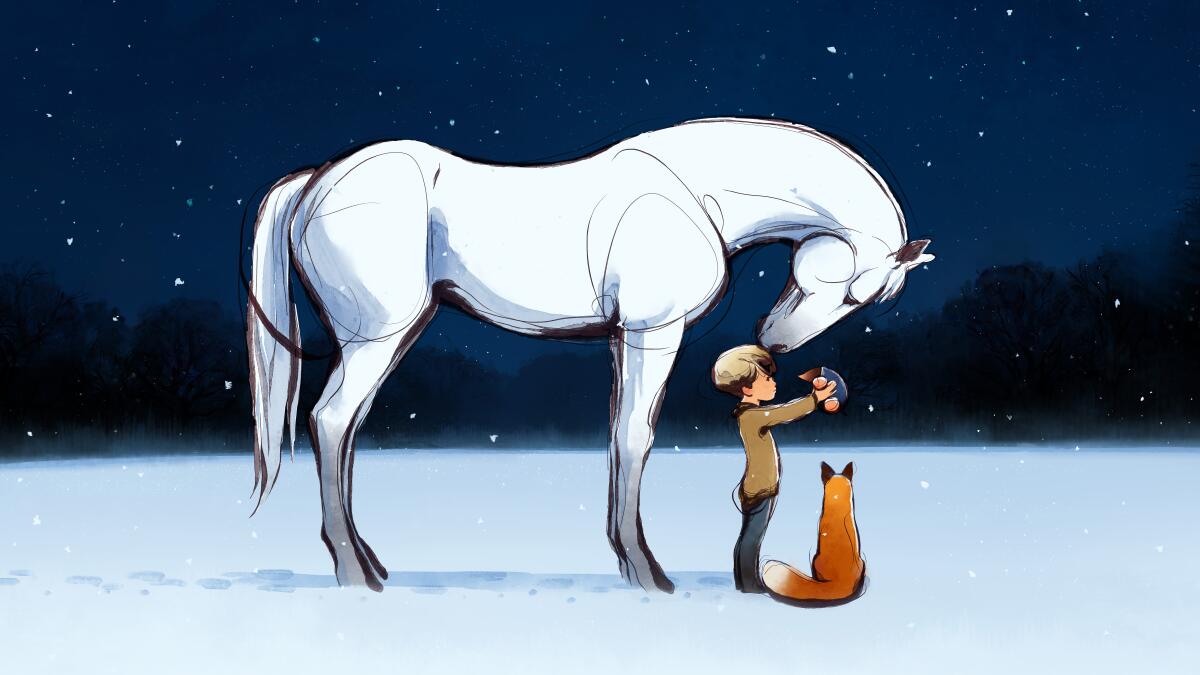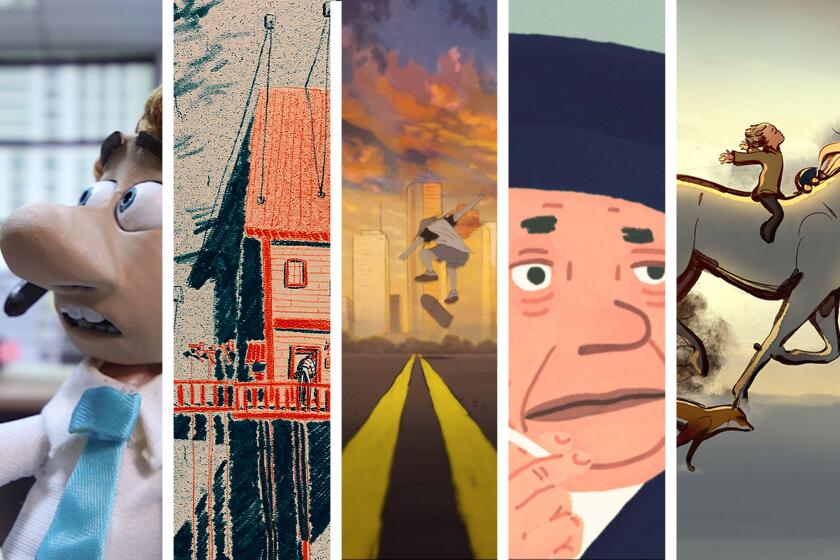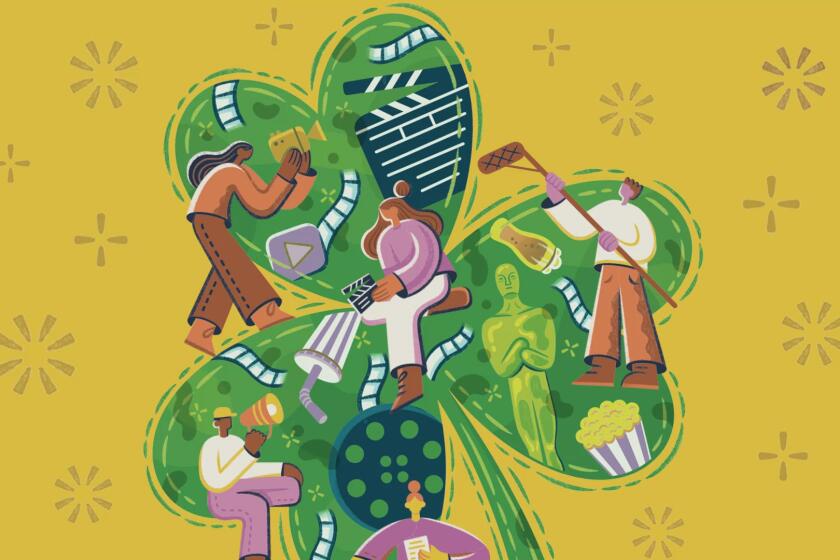With characters wise and reassuring, animated short ‘The Boy, the Mole ... ‘ comforts

- Share via
A lot has changed for Charlie Mackesy in the last few years. The British author and artist remembers lying in his bed and imagining the characters from his book “The Boy, the Mole, the Fox and the Horse” moving across the ceiling. He could see the snow falling. He could hear a score in his mind. But he never anticipated he would actually co-write and co-direct a film version of that story. Or that the film would eventually be nominated for an animated short film Oscar.
“I feel shocked and emotional and grateful, all at once, permanently,” Mackesy says, speaking over Zoom from London. “I fall asleep feeling shocked and grateful and very emotional, and I wake up feeling the same. The book was born out of friendship and conversation, and that’s the same with the film.”
Mackesy initially began drawing the thoughtful characters for his friends, sharing the images in a WhatsApp group and later posting them on Instagram. Their musings, about hope, fear and kindness resonated strongly, so Mackesy created a narrative for them. The story follows a young boy who becomes lost in the forest. There he befriends a cake-loving mole, a wise horse and a mischievous fox. Together, they traverse the snowy wilderness and find solace in each other’s company as they ask questions and offer possible answers. Like the book, the film is filled with wise adages about why it’s important to weather the storm with friends by your side, and using vulnerability as a strength.
The illustrated book was released in 2019 and quickly became a record-breaking bestseller. In the months after its release, the artist and his team were approached with numerous offers to adapt the book for the screen. Ultimately, though, Mackesy decided to retain creative control.
A strong crop of 2023 Oscar-nominated animated short films offers diverse styles, stories and messages.
“In the end, we just felt we wanted to do it ourselves, because we didn’t want to give away the messaging,” he says of the film, released in the UK by the BBC and globally on Apple TV+. “The point of the book was not to make money or sell things. It wasn’t a commercial venture. I wanted to say something that might help someone somewhere, to make someone feel better. I had no idea that it would do what it did. I just wanted to make something that someone could hold. For me, the motive of the book had to be the same in the film. If the book had an effect on people in a certain way, I was really hopeful that the film would do the same.”
The vision was to create a short film with traditional hand-drawn animation that brought Mackesy’s original drawings to life while retaining their sketch-like quality. The author, who co-directed the film with animator Peter Baynton, spent two years working with the team over Zoom to get the film right. Around 120 animators from around the world collaborated on the animation, which was drawn first in pencil and then inked over and hand-painted.

“Everybody on the team had two jobs, really,” Mackesy recalls. “One was to get on with their job making the film, and the other one was to help me understand the processes. It was a very long journey where we were all collectively trying to learn a [visual] language. I wanted the film to make someone [who saw it] feel more comfortable in their own skin or better about themself or more hopeful.”
Translating the book illustrations into moving animation was a challenge. Mackesy’s drawings have a specific loose fluidity, which the filmmakers wanted to retain in the film’s scenes. Baynton created a new pen nib specifically for the inked outlines, and the team used real animals as reference for their movements. In the book, the boy’s face is obscured, so Mackesy and the animators needed to discover what he looked like.
“All these things took months and months,” Mackesy notes. “Looking back on it now, in the middle of it I didn’t quite realize how intense and difficult it all was for everybody. And when you see the film, it looks so simple. But it really wasn’t.”
To voice the characters, the filmmakers enlisted Jude Coward Nicoll, Tom Hollander, Idris Elba and Gabriel Byrne. Mackesy had always imagined Hollander as the mole, a cheeky character who was inspired by the artist’s dachshund, and he instinctively felt the horse needed to be Irish. He mailed a handwritten letter to Byrne with his phone number on it, and three weeks later the actor called.
“I said, ‘So do you know the book?’” Mackesy remembers. “He said, ‘I’ve got it.’ I said, ‘That’s good. So what do you think about doing the voice?’ There was a long pause and he goes, ‘Charlie, I am the horse.’ I cried, actually, because his voice is so rich and deep and Irish.”
Acting, directing, films and more — the Emerald Isle has ties to 14 nominations this Oscar season
For Mackesy, the joy of the film is how it connects with audiences of all ages and backgrounds. His characters are reassuring, often speaking in wise platitudes that feel universally relatable. Nominations from the film academy and BAFTA are flattering, but Mackesy just wants everyone to feel OK about being metaphorically lost in the woods.
“I was just working from an instinct and working from a desire to say things that I knew were true and that had helped me so they might help someone else,” Mackesy says of his original intention with the drawings. “I think you get to an age where you just think you know, ‘What does really matter?’ And if you think you have an inkling of what does matter, then try and say it. Not in a sort of moralizing way. What I like about the characters is none of them are saying they’re better than the others. They’re all on a journey together trying to work it out. I’m the same: I’m just trying to work it out. I’m not on the other side of the river saying, ‘This is how you get across.’ It’s, ‘Wow, that’s a pretty big river. Let’s talk about it.’”
More to Read
Sign up for The Envelope
Get exclusive awards season news, in-depth interviews and columnist Glenn Whipp’s must-read analysis straight to your inbox.
You may occasionally receive promotional content from the Los Angeles Times.









